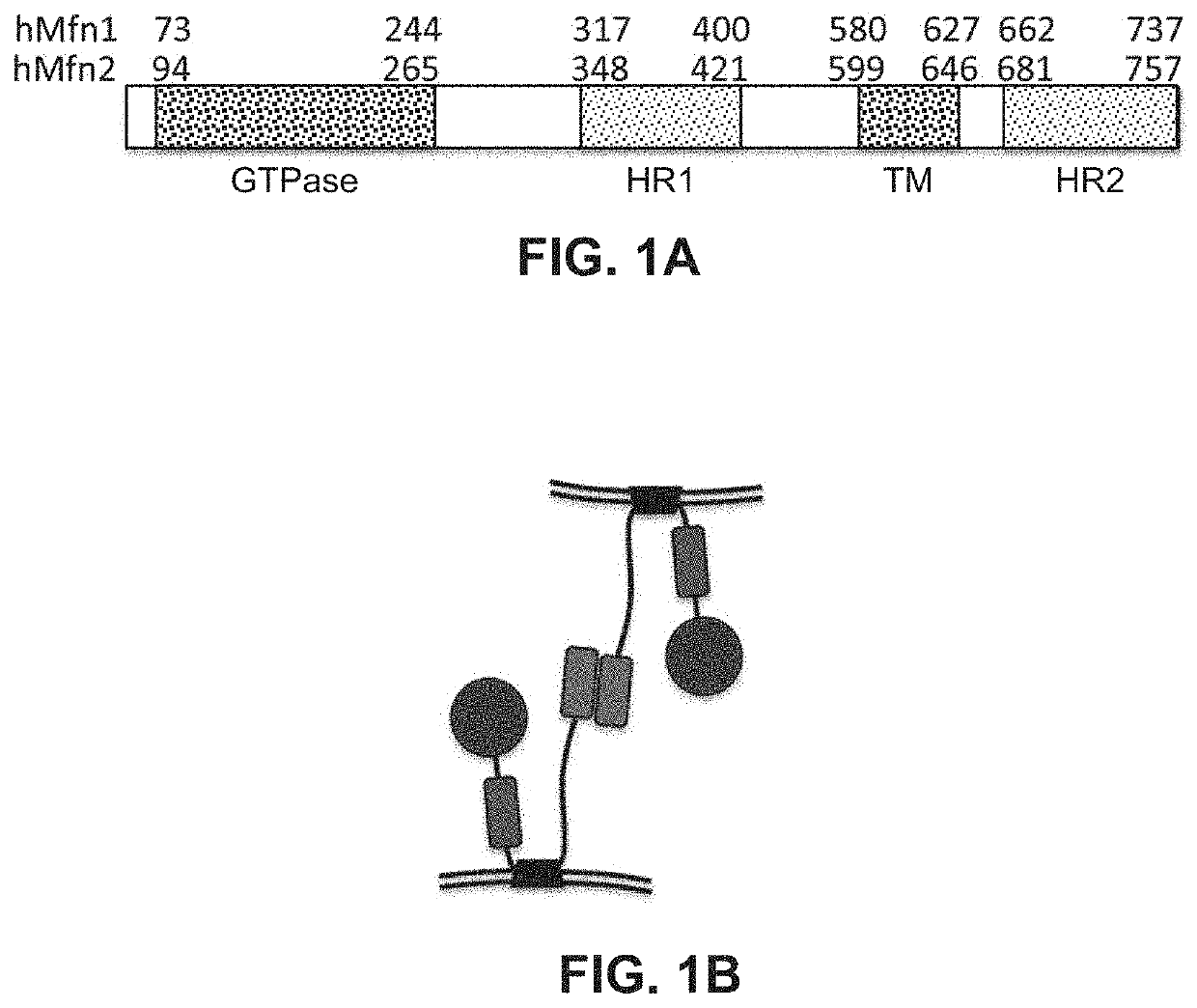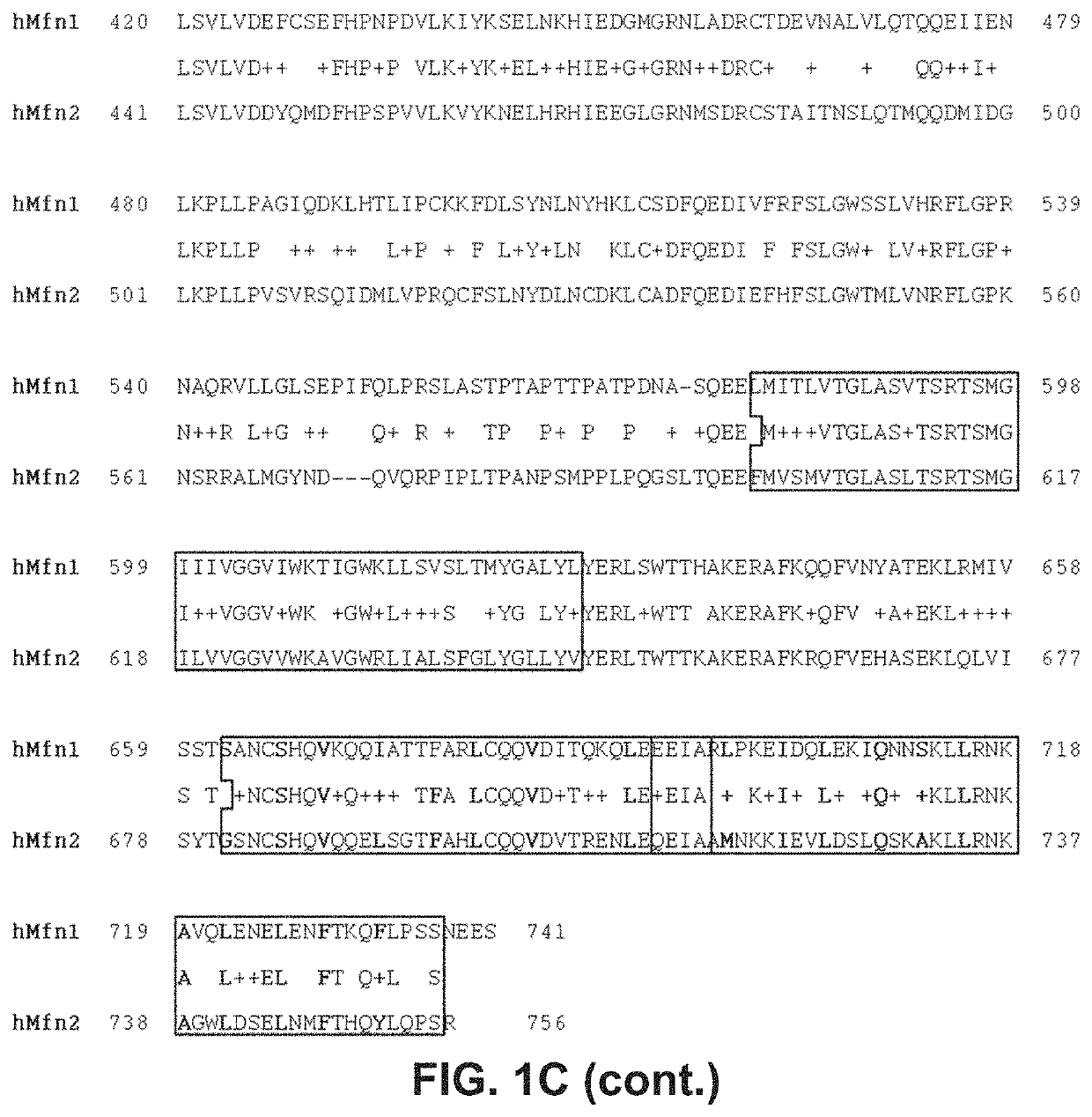Peptide regulators of mitochondrial fusion and methods of use
a technology of mitochondrial fusion and peptides, which is applied in the direction of peptides, peptide/protein ingredients, instruments, etc., can solve the problems of limited development of therapeutically effective approaches, lack of non-genetic means for regulating mitofusins, and inability to directly modulate mitochondrial fusion, so as to increase the mitochondrial aspect ratio, and reduce the effect of mitochondrial clumping
- Summary
- Abstract
- Description
- Claims
- Application Information
AI Technical Summary
Benefits of technology
Problems solved by technology
Method used
Image
Examples
example 1
Materials and Methods
[0139]Cell Lines—
[0140]Wild-type murine embryonic fibroblast cells (MEFs) were prepared from E10.5 C57 / b6 mouse embryos. SV-40 T antigen-immortalized Mfn1 null (“Mfn1 KO,” ATCC No. CRL-2992), Mfn2 null (“Mfn2 KO,” ATCC No. CRL-2993) and Mfn1 / Mfn2 double null MEFs (“Mfn DKO,” ATCC No. CRL-2994) were purchased from ATCC. MEFs conditionally expressing the human Mfn2 T105M mutation were prepared from E10.5 embryos of C57BL / 6-Gt(ROSA)26Sor[tm1(CAG-MFN2*T105M)Dple] / J mice purchased from The Jackson Laboratory (Stock No: 025322). MEFs were maintained in DMEM containing 4.5 g / L glucose (or galactose when specified) supplemented with 10% fetal bovine serum, 1× nonessential amino acids, 2 mM L-glutamine, 100 U / ml penicillin and 100 μg / ml streptomycin.
[0141]Adenoviral Stocks—
[0142]Empty adenovirus (Ad-CMV-Null; #1300) and adenoviri expressing β-Galactosidase (Ad-CMV-b-Gal; #1080) or Cre recombinase (Ad-CMV-iCre; #1045) were from Vector Biolabs. Adenoviral expression vector...
example 2
Computational Modeling of Mfn2 Structure
[0153]In order to design peptides which can bind to and modulate Mfn1 and / or Mfn2, computational modeling was performed based on the known structure of the Dpr1 protein which has significant amino acid sequence identity with both Mfn1 and Mfn2. Specifically, the I-TASSER (Iterative Threading ASSEmbly Refinement) hierarchical approach to protein structure was used to determine the structural model of MFN2 (Yang et al., 2015, Nat Methods, 12:7-8). Structural templates were identified from the PDB database through sequence similarity searches (threading). The top ten solutions were based on the bacterial dynamin-like protein (DLP) structures in the Protein Data Bank (PDB ID: 2J69; Low and Lowe, 2006, Nature, 44:766-769). The confidence of each model was quantitatively measured by C-score that was calculated based on the significance of threading template alignments and the convergence parameters of the structure assembly simulations. C-score was ...
example 3
Modulatory Peptide Design and Synthesis
[0155]After modeling the structural interaction of the Mfn2 HR1 and HR2 domains as described in Example 1, three peptides were designed which contained an amino acid sequence derived from Mfn2 to test the concept of regulatory peptides which can affect HR1-HR2 interaction. Two peptides correspond to residues within the HR1 region of Mfn2 and flanking the HR1 REQQ bend: residues 367-384 (SEQ ID NO:13) and residues 398-418 (SEQ ID NO:17). A third peptide was designed based on the sequence of the adjacent C-terminal area between HR1 and the transmembrane domain, corresponding to residues 428-448 (SEQ ID NO:20). Because these peptides are derived from α-helical domains, the peptides were designed to have a length of about 20 amino acids in order to conserve their secondary structure. Peptides having about 20 amino acids were predicted to create a stable α-helix of about 5 turns. It was also considered that the native approximately 20 amino acid pep...
PUM
| Property | Measurement | Unit |
|---|---|---|
| mitochondrial aspect ratio | aaaaa | aaaaa |
| mitochondrial aspect ratio | aaaaa | aaaaa |
| aspect ratio | aaaaa | aaaaa |
Abstract
Description
Claims
Application Information
 Login to View More
Login to View More - R&D
- Intellectual Property
- Life Sciences
- Materials
- Tech Scout
- Unparalleled Data Quality
- Higher Quality Content
- 60% Fewer Hallucinations
Browse by: Latest US Patents, China's latest patents, Technical Efficacy Thesaurus, Application Domain, Technology Topic, Popular Technical Reports.
© 2025 PatSnap. All rights reserved.Legal|Privacy policy|Modern Slavery Act Transparency Statement|Sitemap|About US| Contact US: help@patsnap.com



